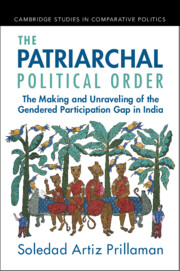 The Patriarchal Political Order
The Patriarchal Political Order Book contents
- The Patriarchal Political Order
- Cambridge Studies in Comparative Politics
- The Patriarchal Political Order
- Copyright page
- Dedication
- Contents
- Figures
- Tables
- Acknowledgments
- Part I The Puzzle of Women’s Political Participation
- Part II The Patriarchal Political Order
- 4 The Patriarchal Political Household
- 5 Political Behavior under Household Cooperation
- 6 The Patriarchal Political Order
- Part III The Unraveling
- Part IV Consequences of Inclusion
- Appendices
- References
- Index
- Other Books in the Series (continued from page iii)
6 - The Patriarchal Political Order
Networks and the Nature of Political Organization
from Part II - The Patriarchal Political Order
Published online by Cambridge University Press: 30 November 2023
- The Patriarchal Political Order
- Cambridge Studies in Comparative Politics
- The Patriarchal Political Order
- Copyright page
- Dedication
- Contents
- Figures
- Tables
- Acknowledgments
- Part I The Puzzle of Women’s Political Participation
- Part II The Patriarchal Political Order
- 4 The Patriarchal Political Household
- 5 Political Behavior under Household Cooperation
- 6 The Patriarchal Political Order
- Part III The Unraveling
- Part IV Consequences of Inclusion
- Appendices
- References
- Index
- Other Books in the Series (continued from page iii)
Summary
Chapter 6 illustrates that household political cooperation begets a system of political organization that centers on men. Using network data from a census survey, it describes the structure of the overall village political network, including gender homophily of political ties, centrality in the entire network, and the average degree of connectivity between individuals and political elites. It shows that village political networks are structured such that men comprise the center of the network, while women remain on the periphery. As a result, influence is concentrated among men, and village politics is structured around men’s other intersecting identities, namely caste. It then compares the size and composition of women’s and men’s political networks and show that women are connected to village politics largely through the men in their household. For men, women do not register as political actors. Household political cooperation thus implies strong limits on women’s access to power, influence, and information and yields a broader gender and political system that perpetuates male dominance.
- Type
- Chapter
- Information
- The Patriarchal Political OrderThe Making and Unraveling of the Gendered Participation Gap in India, pp. 133 - 158Publisher: Cambridge University PressPrint publication year: 2023
